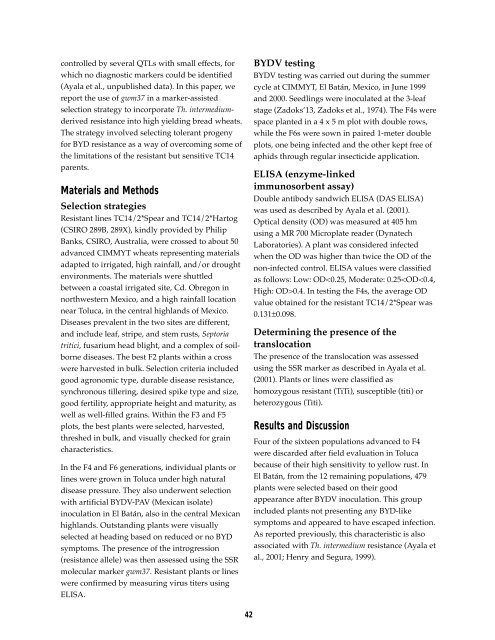Research Highlights of the CIMMYT Wheat Program 1999-2000
Research Highlights of the CIMMYT Wheat Program 1999-2000
Research Highlights of the CIMMYT Wheat Program 1999-2000
Create successful ePaper yourself
Turn your PDF publications into a flip-book with our unique Google optimized e-Paper software.
controlled by several QTLs with small effects, for<br />
which no diagnostic markers could be identified<br />
(Ayala et al., unpublished data). In this paper, we<br />
report <strong>the</strong> use <strong>of</strong> gwm37 in a marker-assisted<br />
selection strategy to incorporate Th. intermediumderived<br />
resistance into high yielding bread wheats.<br />
The strategy involved selecting tolerant progeny<br />
for BYD resistance as a way <strong>of</strong> overcoming some <strong>of</strong><br />
<strong>the</strong> limitations <strong>of</strong> <strong>the</strong> resistant but sensitive TC14<br />
parents.<br />
Materials and Methods<br />
Selection strategies<br />
Resistant lines TC14/2*Spear and TC14/2*Hartog<br />
(CSIRO 289B, 289X), kindly provided by Philip<br />
Banks, CSIRO, Australia, were crossed to about 50<br />
advanced <strong>CIMMYT</strong> wheats representing materials<br />
adapted to irrigated, high rainfall, and/or drought<br />
environments. The materials were shuttled<br />
between a coastal irrigated site, Cd. Obregon in<br />
northwestern Mexico, and a high rainfall location<br />
near Toluca, in <strong>the</strong> central highlands <strong>of</strong> Mexico.<br />
Diseases prevalent in <strong>the</strong> two sites are different,<br />
and include leaf, stripe, and stem rusts, Septoria<br />
tritici, fusarium head blight, and a complex <strong>of</strong> soilborne<br />
diseases. The best F2 plants within a cross<br />
were harvested in bulk. Selection criteria included<br />
good agronomic type, durable disease resistance,<br />
synchronous tillering, desired spike type and size,<br />
good fertility, appropriate height and maturity, as<br />
well as well-filled grains. Within <strong>the</strong> F3 and F5<br />
plots, <strong>the</strong> best plants were selected, harvested,<br />
threshed in bulk, and visually checked for grain<br />
characteristics.<br />
In <strong>the</strong> F4 and F6 generations, individual plants or<br />
lines were grown in Toluca under high natural<br />
disease pressure. They also underwent selection<br />
with artificial BYDV-PAV (Mexican isolate)<br />
inoculation in El Batán, also in <strong>the</strong> central Mexican<br />
highlands. Outstanding plants were visually<br />
selected at heading based on reduced or no BYD<br />
symptoms. The presence <strong>of</strong> <strong>the</strong> introgression<br />
(resistance allele) was <strong>the</strong>n assessed using <strong>the</strong> SSR<br />
molecular marker gwm37. Resistant plants or lines<br />
were confirmed by measuring virus titers using<br />
ELISA.<br />
BYDV testing<br />
BYDV testing was carried out during <strong>the</strong> summer<br />
cycle at <strong>CIMMYT</strong>, El Batán, Mexico, in June <strong>1999</strong><br />
and <strong>2000</strong>. Seedlings were inoculated at <strong>the</strong> 3-leaf<br />
stage (Zadoks’13, Zadoks et al., 1974). The F4s were<br />
space planted in a 4 x 5 m plot with double rows,<br />
while <strong>the</strong> F6s were sown in paired 1-meter double<br />
plots, one being infected and <strong>the</strong> o<strong>the</strong>r kept free <strong>of</strong><br />
aphids through regular insecticide application.<br />
ELISA (enzyme-linked<br />
immunosorbent assay)<br />
Double antibody sandwich ELISA (DAS ELISA)<br />
was used as described by Ayala et al. (2001).<br />
Optical density (OD) was measured at 405 hm<br />
using a MR 700 Microplate reader (Dynatech<br />
Laboratories). A plant was considered infected<br />
when <strong>the</strong> OD was higher than twice <strong>the</strong> OD <strong>of</strong> <strong>the</strong><br />
non-infected control. ELISA values were classified<br />
as follows: Low: OD

















